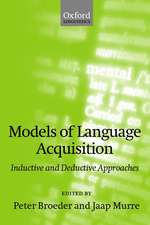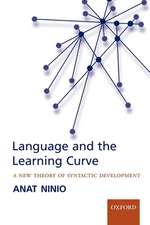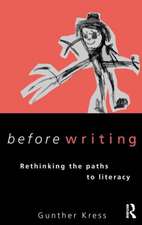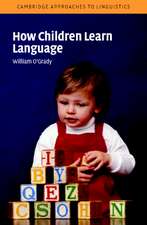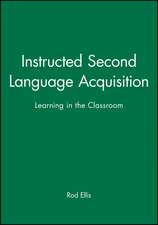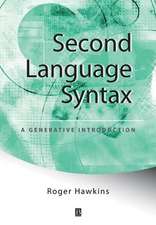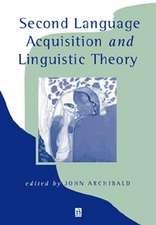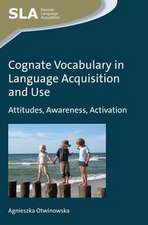Language Power and Hierarchy: Multilingual Education in China
Autor Dr Linda Tsungen Limba Engleză Paperback – 20 apr 2016
| Toate formatele și edițiile | Preț | Express |
|---|---|---|
| Paperback (1) | 257.76 lei 6-8 săpt. | |
| Bloomsbury Publishing – 20 apr 2016 | 257.76 lei 6-8 săpt. | |
| Hardback (1) | 949.17 lei 6-8 săpt. | |
| Bloomsbury Publishing – 22 oct 2014 | 949.17 lei 6-8 săpt. |
Preț: 257.76 lei
Preț vechi: 295.54 lei
-13% Nou
Puncte Express: 387
Preț estimativ în valută:
49.33€ • 53.56$ • 41.44£
49.33€ • 53.56$ • 41.44£
Carte tipărită la comandă
Livrare economică 22 aprilie-06 mai
Preluare comenzi: 021 569.72.76
Specificații
ISBN-13: 9781474283441
ISBN-10: 1474283446
Pagini: 264
Dimensiuni: 156 x 234 x 14 mm
Greutate: 0.38 kg
Ediția:NIPPOD
Editura: Bloomsbury Publishing
Colecția Bloomsbury Academic
Locul publicării:London, United Kingdom
ISBN-10: 1474283446
Pagini: 264
Dimensiuni: 156 x 234 x 14 mm
Greutate: 0.38 kg
Ediția:NIPPOD
Editura: Bloomsbury Publishing
Colecția Bloomsbury Academic
Locul publicării:London, United Kingdom
Caracteristici
Explores the mediation between religion and culture in multi-ethnic schools.
Notă biografică
Linda Tsung is an Associate Professor in the Faculty of Arts and Social Sciences, The University of Sydney, Australia.
Cuprins
List of maps and figuresList of tablesForeword PrefaceAbbreviations1. Introduction 2. Multilingualism in China: diversity, hierarchy and power3. Maintaining Mongolian language in Inner Mongolia 4. Becoming bilingual and trilingual in Xinjiang 5. The debate on Tibetan education in Qinghai6. Harnessing multilingualism: linguistic vitality in Yunnan 7. Rethinking multilingualism: the new literacy in Guangxi 8. Challenges and barriers for multilingualism and multilingual educationBibliography Index
Recenzii
Tsung's book is an important resource, a ground-breaking study that fills a gap in our understanding of multilingualism, language policy, social change and education in China. The country now requires improved multilingual education in order to create a harmonious society, and this book can be a catalyst for change.
In addition to its data-rich survey of Mongolian, Uighur, Tibetan and other minority language instruction across China, Linda Tsung's brilliant new study casts new light on theoretical and practical issues surrounding multilingualism as a global phenomenon and its impact on social, cultural, social and political life in contemporary China.
Linda Tsung's book is a ground-breaking study of the complex issue of multilingualism in contemporary China. Backed by primary sources and years of extensive fieldwork in vast Chinese ethnic minority regions, the author reveals the challenges that all stakeholders must face in negotiating the tension among the diverse forces of globalization, nationalization, language maintenance, social development, among others. It is as theoretically fascinating for linguists as practically valuable for policy makers.
Linda Tsung does what few linguists do well: she takes us into a mysterious world and shows us what the sociolinguistic reality is like there. This is the first book that has empirically and systematically examined the multilingual norms and multilingual education in China, a nation now standing at the crossroads with confusion, and hesitation.
This book is both an empirically rich account and theoretically significant critique of China's policies and practices of multilingualism and multilingual education Skilfully navigating amongst several different ethnic minority languages and communities in China, Linda Tsung directs us to the opportunities and challenges of multilingualism. The book is of relevance to a wide range of people interested in language policy, education, and social change in China.
In addition to its data-rich survey of Mongolian, Uighur, Tibetan and other minority language instruction across China, Linda Tsung's brilliant new study casts new light on theoretical and practical issues surrounding multilingualism as a global phenomenon and its impact on social, cultural, social and political life in contemporary China.
Linda Tsung's book is a ground-breaking study of the complex issue of multilingualism in contemporary China. Backed by primary sources and years of extensive fieldwork in vast Chinese ethnic minority regions, the author reveals the challenges that all stakeholders must face in negotiating the tension among the diverse forces of globalization, nationalization, language maintenance, social development, among others. It is as theoretically fascinating for linguists as practically valuable for policy makers.
Linda Tsung does what few linguists do well: she takes us into a mysterious world and shows us what the sociolinguistic reality is like there. This is the first book that has empirically and systematically examined the multilingual norms and multilingual education in China, a nation now standing at the crossroads with confusion, and hesitation.
This book is both an empirically rich account and theoretically significant critique of China's policies and practices of multilingualism and multilingual education Skilfully navigating amongst several different ethnic minority languages and communities in China, Linda Tsung directs us to the opportunities and challenges of multilingualism. The book is of relevance to a wide range of people interested in language policy, education, and social change in China.




